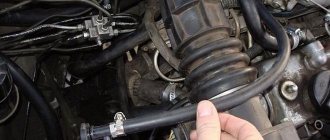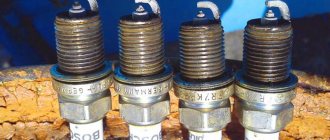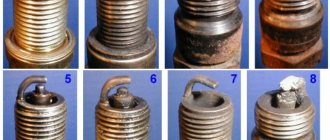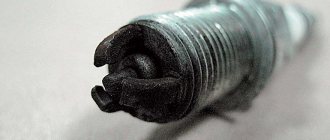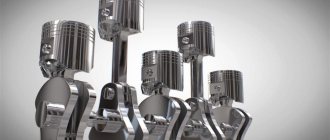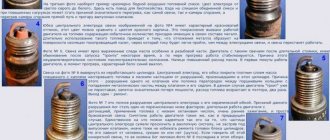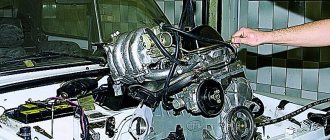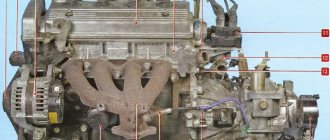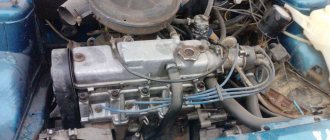What is soot
Since the piston is the first part that takes the load from the ignition of the combustible mixture (takes the blow), it is constantly exposed to temperature, mechanical and chemical influences.
Soot is the formation of a layer as a result of burnt chemicals contained in the supplied fuel. Fuel contains various additives and impurities. When decomposed fuel substances come into contact with hot internal combustion engine parts (pistons, cylinders, valves, connecting rods), these substances stick to the hot metal and settle. Carbon deposits form especially quickly on the pistons due to incomplete combustion of the fuel-air mixture and the breakdown (decomposition) of engine oil. In other words, carbon deposits are deposits that interfere with the normal operation of the internal combustion engine, so it must be removed. Carbon removal is also called decarbonization.
The formation of carbon deposits on intake valves, piston heads, and walls of combustion chambers is the most common occurrence.
The composition of carbon deposits includes ash and carbon compounds. Solid deposits of ash + impurities and particles of unburned fuel and motor oil, also called coke. If there is a lot of coke on several parts, this is already coking of the engine.
Decarbonization of piston rings in the engine
Engine decarbonization is a procedure that extends the service life of the most important elements of the power unit (cylinder-piston group, gas distribution and valve mechanism), and is also a mandatory preventive measure that must be carried out regularly if all technological requirements are met.
How does engine contamination occur?
- During engine operation, numerous processes occur that convert chemical energy into thermal energy and subsequently thermal energy into mechanical energy. At the same time, combustion products are formed in the combustion chambers and carbon deposits accumulate.
- Some moving elements inside the engine begin to become covered with a viscous coating or varnish.
- The oil supply system stops working correctly due to the formation of sludge.
Soot, sludge and varnish have different conditions of formation:
- Soot is a residue of combustion products and is formed as a result of high-temperature processes.
- Varnishes are formed as a result of oil entering the hot zone of the engine, where polymerization and oxidation processes lead to the formation of deposits on metal surfaces.
- Sludge is formed as a result of polymerization of motor oil during its operation and wear (aging, degradation), accelerated at extreme temperatures.
Timely engine decoking can eliminate the negative impact of the above factors on the operation of the internal combustion engine.
We remove carbon deposits from the engine without disassembling it
Over time, deposits begin to accumulate in the car engine, preventing it from working properly. Dealing with carbon deposits is not difficult, this is required.
No matter how often car enthusiasts change the engine oil and no matter how high-quality fuel they select, carbon deposits still appear over time in one way or another. Moreover, it forms almost everywhere: on pistons, valves. Its presence on the rings significantly reduces their mobility.
The reasons for the large amount of soot are primarily due to low-quality fuel, which does not burn completely. They may also consist of incorrectly selected oil or low quality oil.
It is very harmful to immediately load a cold internal combustion engine. It is important to warm it up.
How can you tell if your internal combustion engine is heavily polluted?
In this case, the car begins to constantly overheat for no apparent reason. That is, there is no leak, the antifreeze is normal, but the car overheats, the cooling fan works all the time. The reason for this is the deterioration of heat transfer.
When starting the internal combustion engine after a long stop (about 5 - 6 hours in summer and more than 3 hours in winter), black smoke comes out of the exhaust pipe for about half a minute or less. The internal combustion engine does not operate quite smoothly after it is started. After warming up, engine performance immediately improves. The interior may feel burnt. The “traction” becomes worse - the car takes longer to gain speed. Fuel is consumed more than usual by about 1/5. When the ignition is turned off, detonation may occur. As a result, a noticeable vibration is felt. This is due to the combustion of the remaining fuel. It ignites from heated carbon deposits.
Is it possible to remove carbon deposits without disassembling the engine?
So, you need to buy compressed air (it is sold in cans), a syringe with a tube and a liquid intended for decarbonization. The pistons will need to be set to the same level. Use the key to turn the crankshaft pulley, or lift the front wheel, then engage fifth gear, then start turning the wheel. A tube and syringe are useful for pouring liquid. Decarbonization will take time, about 2 hours, but more is better. Then the liquid should be removed from the wells. After this, you need to blow out the spark plug wells with compressed air. Then you should get into the car, turn on the ignition, press the gas and turn the starter for 5 seconds. After this, put the spark plugs back and start the car engine. It should work for about ten minutes. Initially, black smoke will be observed, which means that the product remaining in the engine is burning through.
To clean the rest of the internal combustion engine, flushing oil is required. It requires driving approximately 100 kilometers. When traveling, there is no need to put any load on the engine. Then the oil should be washed off, fill with regular oil and drive the car quietly, the washing is completed.
Liked? Give it a class! Subscribe to the channel if you like cars
!
Source
Removing deposits from the combustion chamber and piston
This method is designed for the solvent cleaner to be poured directly into the combustion chamber. Thanks to this, the soot loosens. And after the engine resumes operation, all deposits simply burn off. It should be borne in mind that this type of decarbonization will require more aggressive means. The most effective of them is considered to be the Lavr cleaner or its analogues.
In order to quickly decarbonize without removing the power unit and not spend too much time, you must follow the sequence of work:
- Warm up the engine to operating temperature, without allowing it to cool, and remove the spark plugs.
- Set the pistons to the middle position by lifting the car with a jack (for rear-wheel drive cars, you need to jack up the wheel at the back, and with front-wheel drive, at the front).
- Engage fourth or fifth gear and crank the engine using a raised wheel.
- After this, the location of the pistons is determined using a screwdriver inserted through the spark plug hole into the combustion chamber. After this, you can pour decoking agent into each cylinder and leave the car for 30-40 minutes.
- After time has passed, go to the understood wheel and spin it up or down. This must be done so that the cleaner flows to the rings. Such actions should be performed for at least 5-10 minutes.
- Now you should crank the engine using the starter with the spark plugs removed. It will only take 15-20 seconds. During this procedure, residual fluids are removed from the cylinders through spark plug wells.
This product will help clean the piston from carbon deposits.
Don't know how to clean the engine piston from carbon deposits?
Schumann to the rescue! The stove and oven cleaner not only copes with grease in the kitchen, but also perfectly removes fossilized carbon deposits on pistons. It is true that in some cases this is contraindicated.
Often car enthusiasts who disassemble and repair engines wonder how to clean carbon deposits on pistons? There are quite a lot of proposals - from special means to banal soaking in gasoline, diesel fuel, kerosene or some kind of solvents, but this is often ineffective.
The product for cleaning ovens and stoves contains alkali, which is why it is very caustic and quickly and easily dissolves carbon deposits (both at the top and in the hard-to-reach grooves of the piston rings). Therefore, if you need to clean the oil channel on the piston, you can take a plate cleaner, but you need to apply it for a short time and on the pistons without special spraying, otherwise there will be trouble!
The main disadvantages of the product: excessive causticity
and something that can
only be used if the engine is disassembled
and the part is already in hand.
To clean pistons from carbon deposits without disassembling the engine, dimexide is used in the same budgetary way, but there are a number of reasons why this should not be done, they are described here
.
Indisputable advantages: completely removes any carbon deposits
, you can
clean both the piston and the valves
; the best tool
for decoking the oil channels
in the piston is always
available in the kitchen
.
To clean the piston, the best option would be to use a gel-like product or spray, but cream or powder ones are less effective. Therefore, if you have a difficult case, then it is better not to use any of the cleaning products for stoves and ovens, but only: Schumanite, Amway Oven Cleaner or the like, which contains surfactants, solvents, sodium hydroxide, or better yet, organic acid (then it will also be safe for aluminum parts).
Products containing alkali (caustic soda) damage the protective oxide film on the aluminum piston, causing it to darken and succumb to oxidation. Therefore, it is strictly not recommended to keep this composition for longer than 5 minutes.
When one treatment does not bring the desired result, the procedure can be repeated again, and it is better to wrap the coated piston in cellophane so that the product does not dry out but remains on the surface and continues to act until washed off with water.
Yes, this is a dangerous drug
, but very effective and cheap, because a good housewife or owner can always find it in the kitchen. Well, if it’s still a little scary, you’ll have to spend money and buy a special cleaner. Motorists recognized Profoam 1000 as one of the best in this category.
Are you interested in this idea? Give it a thumbs up!
And if you have something to say about this, then don’t hold back and speak up in the comments.
Video about cleaning pistons and valves from carbon deposits
By the way, still not subscribed to the channel? Be sure to subscribe right now if you don’t want to miss another good tip on car maintenance or repair!
Source
Valve cleaner
Valve cleaner must be used periodically to remove carbon deposits from their surface. You can remove it in two ways - with or without dismantling. In the first case, it is necessary to disassemble the engine, which is not always possible, and is simply labor-intensive.
Therefore, most modern car enthusiasts use special valve cleaning products. They are divided into two types - foam and liquid. Foam ones are intended for physical cleaning of the surface, while liquid ones need to be added to gasoline. The following material presents a rating of the most popular means of cleaning valves from carbon deposits, compiled on the basis of reviews and feedback from car enthusiasts.
| Valve Cleaner | Short description | Package volume, ml | Price as of summer 2022, Russian rubles |
| Liqui Moly additive for cleaning valves Ventil Sauber | The valve cleaning liquid that is poured into the tank is therefore a complex additive also for preventive cleaning of the power system and piston rings. | 250 | 500 |
| HI-GEAR Valve and Power System Cleaner | After use, it reduces fuel consumption by approximately 5.7%. | 295; 325 | 550; 600 |
| Valve cleaner Lavr | Effectively cleans not only valves, but also piston rings. Low price with high efficiency. | 310 | 250 |
| Foam decarbonizer “Valera” | A universal product that can be used to clean various engine parts and vehicle exhaust systems. | 210; 400 | 560; 750 |
| Wurth Foam Valve Cleaner | The most popular foam cleaner for intake valves. | 300 | 450 |
White carbon deposits on the piston
Hello everyone, for what reason could there be a white coating on the valves and piston? Cylinders 2 and 3 and valves are perfect, no carbon deposits at all. And cylinders 1 and 4 and valves have a white coating. And when I measured the compression, it was like this: 1 - 25 bar 2 - 30 bar 3 - 20 bar 4 - 15 bar From the 4th cylinder, the cylinder head bolts and so on stink very much. Probably burnt oil. What could be the problem with white plaque?
In the evening I’ll try to post some pictures, I just lost the engine and had to urgently leave for another city; I haven’t studied my problem in detail yet.
I also took the injectors to Bosch service, they said everything was fine with them, within normal limits, the return flow was a little too high. But I don’t know for sure, maybe they deceived me, but what’s the point.
Car e46 320Cd with m47n engine
I asked him to spray it with wd-40, wipe it and take better pictures, there didn’t seem to be any cracks.
Well, the intake valves only let in air. Does excess air cause a white coating to form?
In general, I scattered the block. As a result, the pistons were removed from the block, but they stuck out 2mm and got stuck, there was such a ringing sound, the rings rest against the step. The step is elliptical, the honk at 9 and 3 o'clock remained in other places, erased and the step there is awesome. I haven’t been able to measure the step yet, I’ll probably take it to Mechanics tomorrow, they’ll immediately tell you what to do and how to do it. There were also no feeler gauges to measure the gap in the piston ring lock, but I estimated the caliper with a compass quite accurately, it turned out like this: At the top where the piston had not worn off (not the working surface) the gap was 0.4-0.6 mm And where the piston had bored everything out, there was 1.3 -1-4mm
What do you say? Apparently, most likely it won’t be possible to pinpoint it until the first repair? Won't he clean up this whole thing?
I have a previous 39 with an M51 engine, it has done 400 thousand and would still do the same. An excellent motor in this regard. But the fact that it doesn’t drive and rattles in winter is terrible and eats more. But with a mileage of 400 thousand without a glow plug, it always started with half a turn at -33 degrees! Well, who knows, maybe with a normal engine it will work in any frost. And another question, if suddenly I find a block and there will be a complete factory honour, present everywhere, on the entire surface. So you can even know without measurements that the cylinder clearances are normal?
In general, I probably didn’t listen to anyone. I took this cast-iron weight to the mechanics, they looked at it and said that due to overheating at such a mileage, everything had deteriorated like that. The crankshaft is perfect, just a little polish and that's it. The block is lined, the cylinder head is pressurized and, if anything, the valves with caps are ground in or replaced. They said they repair it all the time and know what's what. They sharpened the crankshaft from 2 refrigerators in front of me. He said that many people don’t trust and don’t like a sleeved motor, but in reality the engines last a long time; in extreme cases, with proper care, this body should be enough after a rebuild.
By the way, what parts does the tensioner consist of? Plastic, spring, piston, spring, piston? something like this? I brought the engine to the mechanics, and suddenly I was inspired to get a nail
As a result, 2 broken frames with photographs and a wall covered in oil. PPC shot for 4 thousand rubles like this.
By the way, what else should be changed besides the block and cylinder head consumables?!
1) All inserts 2) The chains are probably also worth it, after all, it’s already 260 thousand, although the engines run a lot more, they’ll be enough for the same amount or more, maybe then it’s not worth it? 3) All gaskets, seals 4) check the hydraulic compensators, squeeze them with pliers and see if they all open the same way?
I am begging you! The M51 is in any case softer in operation than the M47, if only because it has a 6-cylinder! And the M51 drives, too, I can’t say that it’s worse than the 39th M47! My brother had an E39 with an M47, so he was very lucky, he managed to push it into Raska when he was captured about 4 years ago! He was not happy with this engine!
Added after a minute:
Sorry, I didn’t notice that this is a 46 engine! But still, in terms of performance, the M51 is softer, in terms of agility, the M47 150 strong in the E46 will of course go more fun!
You need to ask the hucksters about money. Yes, and depending on what you have left alive! If you sell the crankshaft and attachments from the M47, then you can get a profit. I’m kidding, of course, but a couple of years ago in the Republic of Belarus they charged 800 euros for the crankshaft from a simple M47. and the M57tu swap has 2 undeniable advantages over the M47n repair: the engine is 218 hp with 6 boilers - it runs well, smoothly and no one took the engine apart for a long time! In terms of money it will definitely be cheaper than capital. but first you need to clarify the electrical connections.
Added after 3 minutes:
I forgot to say - if the car is tired, then it’s better to collect it, sell it as is and not suffer
The fact of the matter is that the car is fresh, mid-2004. Moreover, they don’t sell these 3-liter diesel ones, one is now hanging on Auto.ru for 600, I think.
billi11 I don’t have an m47, but an m47n, two different engines.
I'm aware, but this doesn't even add a fifth cylinder to it!
Risks
It’s understandable that there are positive changes, but there are also chances for negative developments? In addition to the predicted risks of contamination of spark plugs, catalysts and other things, there is also a non-zero chance of getting a piece of coke directly under the piston rings and a scratch on the cylinder bore. Or a large piece of carbon directly under the valve, which can lead to its failure or a collision between the valve and the piston. Fortunately, the chance of this kind of trouble is small, but you shouldn’t forget about this possibility.
About decoking with water, it is worth saying that when using it, the risk of water hammer is quite high, especially if the procedure is carried out carelessly. Many services simply do not take on this work if they are not confident in their abilities.
Methods for removing carbon deposits and coke
- Manual cleaning with disassembly.
- Cleaning with special solvents:
* through spark plug holes;
* through the oil filler neck.
To properly clean pistons from carbon deposits, you must use the manual mechanical cleaning method. If you choose this method, you will have to disassemble the engine and remove the pistons. This process is labor-intensive because you need a garage, knowledge and skill in disassembling the engine, and tools. After disassembly, clean the surface of the pistons with a scraper, then with sandpaper.
- The advantage of manual mechanical cleaning is high-quality removal of soot, coke, and varnish.
- The downside is time and labor.
Soot information
The formation of carbon deposits in the combustion chamber of a gasoline engine is a natural process, but it must be controlled. There are many reasons for this process: low-quality engine oil, constant city driving, the formation of condensation in winter and its mixing with oil, violation of oil change instructions, and many others.
In carburetor engines, carbon deposits are deposited on the pistons and piston rings. The intake valves are washed with an air-gasoline mixture and self-cleaning. In engines with direct injection of a combustible mixture, carbon deposits coke on the valves, since they are not washed by the combustible mixture. Symptoms of contamination of the intake channels and valves may occur after 50 thousand kilometers of the car:
- Power drop up to 40%.
- Unstable engine operation.
- Reduced engine response when accelerating.
- Greater fuel consumption.
- Engine detonation problem.
There are many reasons for contamination of the pistons and throttle body, but the most obvious are frequent short trips, driving in traffic jams, and negative driving habits, such as idling the engine for long periods of time. The deposited carbon on the valves leads to their deformation, burnout and loose fit to the seat, thereby reducing the compression ratio in the combustion chamber.
Wynn's Combustion Chamber Cleaner
High-quality decoking helps to carefully remove carbon deposits, varnish deposits and sludge carbon formations in the CPG of gasoline engines only. The substance helps restore the mobility of oil scraper rings, as well as compression rings, and clean the intake manifold with valves. The product does not have a negative effect on the catalyst. The unusual use of the substance surprises car enthusiasts - it is supplied through the engine vacuum hose, but the high efficiency of the product is noted by equalizing compression in the cylinders, reducing vibrations and eliminating engine detonation. Many users note a minimal level of oil consumption, as well as a significant increase in engine power. The cleaning process does not require lubrication and practically does not harm the motor, since there is no contact with the rubber seals of the engine.
Cleaning pistons from carbon deposits without disassembling
Many people choose the second method of cleaning pistons from carbon deposits - without disassembling. When decoking and sticking of piston rings, a method is used without dismantling engine parts.
The principle of such cleaning is the use of special products that can dissolve the resulting coke and plaque.
Such coke solvents are poured directly through the holes for the spark plugs (through the holes for the glow plugs - for diesel units) or through the lubrication system (neck for filling engine oil). The liquid poured in should dissolve the black carbon deposits that have formed.
Advantages of decarbonization and removal of carbon deposits with a special liquid:
- easy and fast;
- The oil scraper rings will decarbonize.
Minuses:
- Carbon deposits are not removed from the surfaces of the working combustion chamber, pistons and valves;
- It will not cope with a heavily coked engine.
There are two types of cleaning and decoking:
- Soft. If you pour solvent through the spark plug holes, this method is called “hard” cleaning.
- Solid. If through the oil filling hole, this is a “soft” cleaning.
Soft decarbonization
The essence of this method is that before replacing the engine oil, a flushing liquid is poured into the engine with the effect of decoking the piston rings (for example, Liquid Moli, XADO / Xado).
When using this method, it is necessary to study the operating features of the engine after adding this liquid to the engine oil. As a rule, you should not put heavy loads on the engine (using a trailer, large luggage, slipping, exceeding average speed). This is due to the fact that the oil has become diluted and the physical and chemical characteristics of the oil have changed.
This cleaning method, that is, without disassembling the engine, but using a special liquid for decoking and removing carbon deposits from the CPG parts through the oil filler hole, should be used for prevention. Then there will be an effect.
Hard carbon removal
If deposits on the parts of the cylinder-piston group and valves are large, then you can use a non-separable method with pouring into the cylinders through the spark plug holes. Pouring a special soot solvent directly into the combustion chamber softens and peels off soot and coke from the part. Further, during engine operation, the softened plaque particles burn out.
To fill through the spark plug holes, aggressive solvent liquids are used to obtain maximum effect. This is, for example, the company Lavr / Lavr.
Rules for using a special cleaning agent through the spark plug holes:
- Measure the compression of all cylinders. This is not necessary, but it is useful to find out later whether there is a difference in pressure values before and after cleaning.
- Heat the engine to operating temperature.
- Unscrew the spark plugs or glow plugs.
- Set all pistons to the middle position. To do this, turn the generator pulley in neutral or with a raised jack at speed 4 or 5 and turn the drive wheel. Use a tape measure or a screwdriver to check the location of the pistons.
- Pour liquid through the spark plug holes into all cylinders to decarbonize and remove carbon deposits.
- Wait 30 minutes.
- Turn back and forth by the generator pulley in the neutral position of the gearbox or at 4 or 5 speed by the wheel so that the liquid gets into the sockets for the rings to loosen them if they are stuck. Move the pistons every few minutes.
- Turn the ignition key and start with the spark plugs removed so that the pistons expel any remaining fluid through the holes. Do this for about 20 seconds. If a lot of liquid remains, the engine may experience water hammer.
- Screw in the candles.
- Start the car engine. After cleaning pistons, rings, cylinder walls, and valves from carbon deposits and coke using liquid cleaning, the car engine may not start immediately.
- After starting the engine, let it idle for about 15 minutes. Immediately after starting the engine, black exhaust gas and a pungent odor will come out of the muffler.
- Drive a couple of kilometers until the color of the exhaust gases becomes normal.
- Check the oil, if not clean, replace the oil and oil filter.
Piston rings sometimes do not become movable immediately after decoking, however, after a short run the rings become functional.
Valve cleaner ratings
The list of the most popular and effective valve cleaners at the moment consists of 5 products, created on the basis of reviews and reviews found on the Internet. Most of them are used not only to remove carbon deposits on valves, but also to clean piston rings and the power system because deposits settle on all parts of the combustion chamber.
Liqui Moly Ventil Sauber
The Liqui Moly Ventil Sauber valve cleaning additive is one of the most popular such products. This is due to its extreme efficiency. It is a liquid that is added to fuel. It not only removes carbon deposits on valves, but also removes deposits in the power system, injectors, carburetor and intake tract elements. In addition, it prevents the formation of corrosion on metal surfaces, both liquid and electrolytic. Liquid Moly valve cleaner can be used on any type of engine, including those equipped with catalysts and turbocharging.
Reviews of the Liqui Moly Ventil Sauber 1989 valve cleaner are mostly positive. Most car enthusiasts who have used Liquid Moly to clean valves note its high effectiveness. In particular, many write that even quite deep deposits are removed from the surface of the valves, including those formed when using low-quality fuel. Accordingly, engine power increases, and the clicking sounds made by the valves go away. Thus, the cleaner definitely deserves a leading position in the ranking.
The only drawback is the price is a little high compared to its competitors. You can buy the additive in a 250 ml can, which is enough to dissolve in 75 liters of fuel. If the volume of the car tank is smaller, then the product must be poured in proportion. The price of one package as of summer 2020 is about 500 rubles.
HI-GEAR FUEL SYSTEM & VALVES CLEANER
HI-GEAR FUEL SYSTEM & VALVES CLEANER valve cleaner is designed for use with any type of gasoline engine up to 2.5 liters. Including engines equipped with catalysts and turbines. The manufacturer directly states that this product is recommended for preventive use every three thousand kilometers. The additive is poured into the fuel tank, so it also has a positive effect on the power system. The original detergent element included in the product is TFS23. Stops rusting and also reduces fuel consumption by 5...7%.
The HI-GEAR valve cleaner is highly effective. It efficiently and quickly removes not only carbon deposits from valves, but also cleans pistons, as well as elements of the fuel system. Accordingly, there are mostly positive things about him. In rare cases, when the soot is already significant, it may not cope, but since the product is positioned as a preventative, there can be no corresponding claims against it. One of the disadvantages is the high consumption of the additive for a small volume of gasoline.
The High Gear valve cleaner is sold in metal bottles of two different volumes - 295 ml and 325 ml (items HG3235 and HG3236). The volume of the larger jar is enough to dissolve it in 40 liters of gasoline. The price of the smaller can as of the above period is about 550 rubles, and the larger one is about 600 rubles.
Valve cleaner Lavr
Valve and combustion chamber cleaner “Lavr” Ln2134 is the third most popular liquid cleaner among car enthusiasts. Reviews from car owners indicate that it very quickly and efficiently washes not only carbon deposits on valves, but also dirt on other elements, in particular on rings.
Can be used on any gasoline engines, including those with catalysts and turbines. Its use is standard, that is, it must be poured into the fuel tank immediately before refueling, where you then add gasoline and drive until it is empty. The composition contains: a base aliphatic solvent, a package of proprietary detergent additives, aliphatic alcohol and functional active substances.
Valve cleaner “Lavr” increases the power characteristics of the engine, reduces fuel consumption, and reduces the toxicity of exhaust gases. Reviews about the product are mostly positive. There are positive changes in the cleanliness of pistons and valves. So, there is a 310 ml jar on sale, the price of which is about 250 rubles. One jar is enough for 40...60 liters of gasoline.
Foam decarbonizer “Valera”
A domestic product, the Valera foam decarbonizer from VMPAvto 8507, is also very popular for cleaning valves. The product is positioned by the manufacturer as a universal product designed for cleaning engine parts during disassembly, including valves and rings. It effectively removes deposits and dirt.
Foam must be applied to the surface to be treated. After this, leave the foam for 5.7 minutes to perform a chemical reaction so that the carbon deposits dissolve. It is recommended to perform this cycle up to 3.5 times depending on the complexity. The foam must be removed using a syringe, then blow off the surface with compressed air. Therefore, the product will have to be used when partially dismantling some elements or when disassembling the engine.
The “Valera” decarbonizer is popular among both car service professionals and ordinary car enthusiasts, which confirms its effectiveness. To clean carbon deposits from valves or rings, up to 5 cycles are usually carried out. This is enough to remove even the most stubborn carbon deposits. It can be used to clean intake and exhaust manifolds, rings and other parts removed from the engine. Among the disadvantages, one can note only a fairly high price with a large consumption of funds.
Decoking “Valera” is sold in packages of two sizes. The first is 400 ml in volume (enough for processing parts of a 12-cylinder engine), its price is about 750 rubles. The second package volume is 210 ml, costing 580 rubles.
Wurth Foam Valve Cleaner
Valve cleaner "Vert" 0893033 is a foam cleaner, that is, it must be applied inside the intake manifold. According to the instructions, it is fed into the intake manifold on a warm engine running at 2 thousand rpm, in two passes with an interval of 30 minutes.
Why is black carbon deposits on the piston dangerous?
The presence of black carbon deposits on the piston can cause serious damage to the internal combustion engine:
- detonation (sharp explosion of the fuel-air mixture in the combustion chamber);
- glow ignition (the fuel-air mixture ignites on its own due to overheated parts, without supplying a spark);
- dieseling (spontaneous combustion of the fuel-air mixture without a spark, due to high compression).
The appearance of detonation, glow ignition and dieseling significantly reduces the overhaul life of the engine. A sign of glow ignition and dieseling is that the car engine does not stall after switching off.
Advice from experienced drivers
As a result of trial and error, obtained by car enthusiasts when cleaning a car engine, cheap and effective technologies were revealed. Drivers try to flush the combustion chamber with liquid without removing the cylinder head. The composition of the liquid that dissolves dirt was obtained experimentally. Its composition consists of hydrocarbons capable of softening charred oil impurities:
Take the components in equal quantities, usually 0.5 liters each. Pour the mixture into the cylinders overnight. After washing, change the oil.
Gzox Injection & Carb Cleaner
Depending on the method of application, the substance cleans the combustion chamber, decarbonizes piston rings or removes carburetor deposits. The chemical composition of the product helps to achieve instant dissolution of carbon deposits, resins and formations based on them - which restores the mobility of oil scraper rings. Car enthusiasts who have used GZOX INJECTION to restore engine performance note the high efficiency of the substance, which, after cleaning, returns the engine to stable operation and increases throttle response. As practice shows, when decoking is carried out according to the instructions, the result will only be positive. There is no restorative effect, so a diagnostic error or an indication of wear on the oil scraper rings may occur. The manufacturer recommends completely cleaning the lubrication system and changing the oil after using the substance.
How to avoid carbon deposits
To avoid the formation of plaque, soot, and coking of moving and stationary parts of an internal combustion engine, the following preventive measures should be carried out:
- Fill with high-quality motor oil.
- The ignition, the valves, and everything that is needed for the correct operation of the internal combustion engine must be correctly adjusted. The more completely the supplied fuel burns, the less carbon deposits will be on the pistons, valves and combustion chambers. There should be no over-suction or overflow. Therefore, the condition of pistons, cylinders, connecting rods, injectors, spark plugs, valves, valve seals will increase the period of formation of soot and coke.
- Change oil and filters in a timely manner. If you fill in the cheapest oil, then at least you need to change it more often (for example, after 7 thousand kilometers). The cleaner the engine oil, the correspondingly cleaner the parts will be (no soot and coke). When using high-quality expensive motor oils, the replacement schedule is 15 thousand kilometers.
- Pass maintenance in a timely manner.
- Fuel with quality fuel. The fuel liquid contains resins, their content must comply with the standards. Therefore, it is better to refuel your cars at large gas stations.
Also, if desired, before updating the engine oil according to schedule, you can do a “soft” cleaning to prevent the formation of layers of soot and coke.
When high oil consumption begins, problems with the engine have already begun, for example, these are signs that:
- piston oil scraper rings are stuck or worn out;
- not working valve stem seals;
- burnout of valves or coking of valves.
The conclusion from everything described above is that the cost of effort and money for prevention is much less than repairing a coked engine.
This video describes how to decarbonize parts of the cylinder-piston group.
Author of the publication
15
Comments: 25Publications: 324Registration: 04-03-2016

